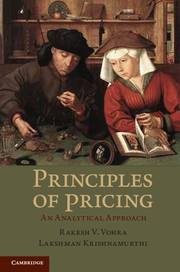2 - Buyer Behavior
Published online by Cambridge University Press: 05 June 2012
Summary
To begin, we consider the simplest nontrivial pricing problem.
The Ultimatum
The world contains just two people: a buyer and a seller. The seller has a book that she values at zero that she wishes to sell to the buyer. It is the only book of its kind in the world and the buyer is fully aware of its contents and condition. The buyer values the book at $10, neither more nor less. Each is aware of how the other values the book. The seller has one chance to set a price. Once the price is fixed, the buyer has one chance to buy at the price posted or to decline. No other inducements, counteroffers, or promises are permitted. What price should the seller set to maximize her revenue?
The usual mysteries that cloud a pricing situation have been stripped away. There is no uncertainty about the nature or quality of the product. The value of the product to the buyer is known, as is the seller's opportunity cost. There are only one seller and one buyer. The dance between seller and buyer is limited to a single take-it-or-leave-it offer.
It is clear that the chosen price should not exceed $10, the value of the book to the buyer. Thus, the only question is just how close to $10 the seller can set the price and have the buyer accept.
- Type
- Chapter
- Information
- Principles of PricingAn Analytical Approach, pp. 6 - 14Publisher: Cambridge University PressPrint publication year: 2012



